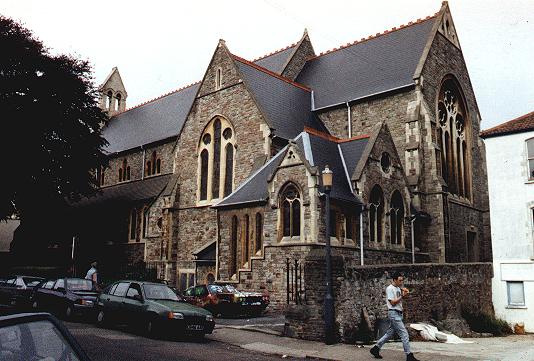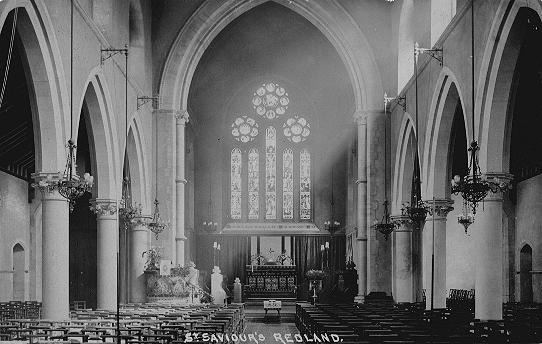|
St Saviour Woolcot Park Redland, Bristol |
 |
As Bristol and Clifton continued to spread, these streets in Redland were without a parish church. Redland Chapel was still a private estate chapel under the parish of Westbury-on-Trym and in anyway was (and still is!) too small to serve as a parish church for the area. A site in Chandos Road was acquired, an iron church erected 1875 and here one of Bristol's larger Victorian churches rose 1882-9 to the designs of John Bevan. It cost £4149. The stone used is the hard Bristol Pennant with Bath Stone dressings.
It survived in use until c1975 when the parish already joined to St Mary Tyndall's Park, purchased the redundant Highbury Chapel which in turn was restored and rededicated to St Saviour & St Mary, Cotham to replace both buildings. St Saviour was then purchased by the Mount of Olives church, who had a flourishing congregation in a former methodist chapel at the top of Blackboy Hill. In August 2000, a notice appeared on the church saying services had transferred elsewhere, and a skip filled with artwork from (?) children's corner and religious records and the like suggests that this congregation are leaving the building too. Indeed the building has been sold with planning permission for conversion into flats.
The church was planned without a tower, but the west face of the double bell-cote is embellished by a rich niche and statue. Bevan chose to use lancet windows for the aisles, becoming stepped triples in the clerestory, and with ugly plate tracery for the main fronts. There is a west narthex, transepts off the choir, and a very handsome arrangement of rooms and vestries at the south-east corner, with stairs to the rooms under the east end.
 |
The interior was tall, long and wide, with six-bayed arcades having tall cylindrical piers and large foliated capitals. I say "was" as since its closure in the 1970s I have been unable to get inside the church. The church was so large that some internal remodelling may have taken place. This early view shows it without the handsome metal screen across the chancel arch. I always suspected that this screen came from St Andrew in Montpelier when that church closed. Indeed Neil Marchant reports that the chancel and transept areas have had a "mezzanine floor" inserted, and that there is a large new mahogony pulpit at the west end. The nave and aisles are largely unaltered but devoid of fittings. Local residents opposed the church being turned into flats in 1999 and these plans were shelved. Since then modified plans were developed and the church interior is lost forever in the new housing conversion that was completed in 2003. |
(If anyone can help with additional information / history of the church please get in touch.)
21 Aug 2004: Dave Anderson writes: "I lived in Bristol when I was a student and I have some detail on this church: The congregation had dwindled to a handful when The Mount of Olives Pentecostal Church - who needed space for 600 worshippers - bought the church. They also needed meeting rooms for their other activities. The architect of the conversion was David Saxon. The nave, alone, was large enough for the congregation so the chancel and transepts each became an attractive meeting room with the floor level raised up to the sill height of the large windows - giving room for ancillary accommodation below. Two new staircases were added in each aisle entirely below the aisle roof - such was the size of the church. Since the entrance was at the centre of the church, the orientation of the nave was reversed - a reclaimed pulpit from the demolished Pentecostal chapel in Tamworth was placed at the west end. The builder was Graham Bird, a member of the new congregation. They sold off what they could, the organ was removed, but the stained glass was a lucky survivor as a buyer couldn't be found."
Back to Bristol churches Index